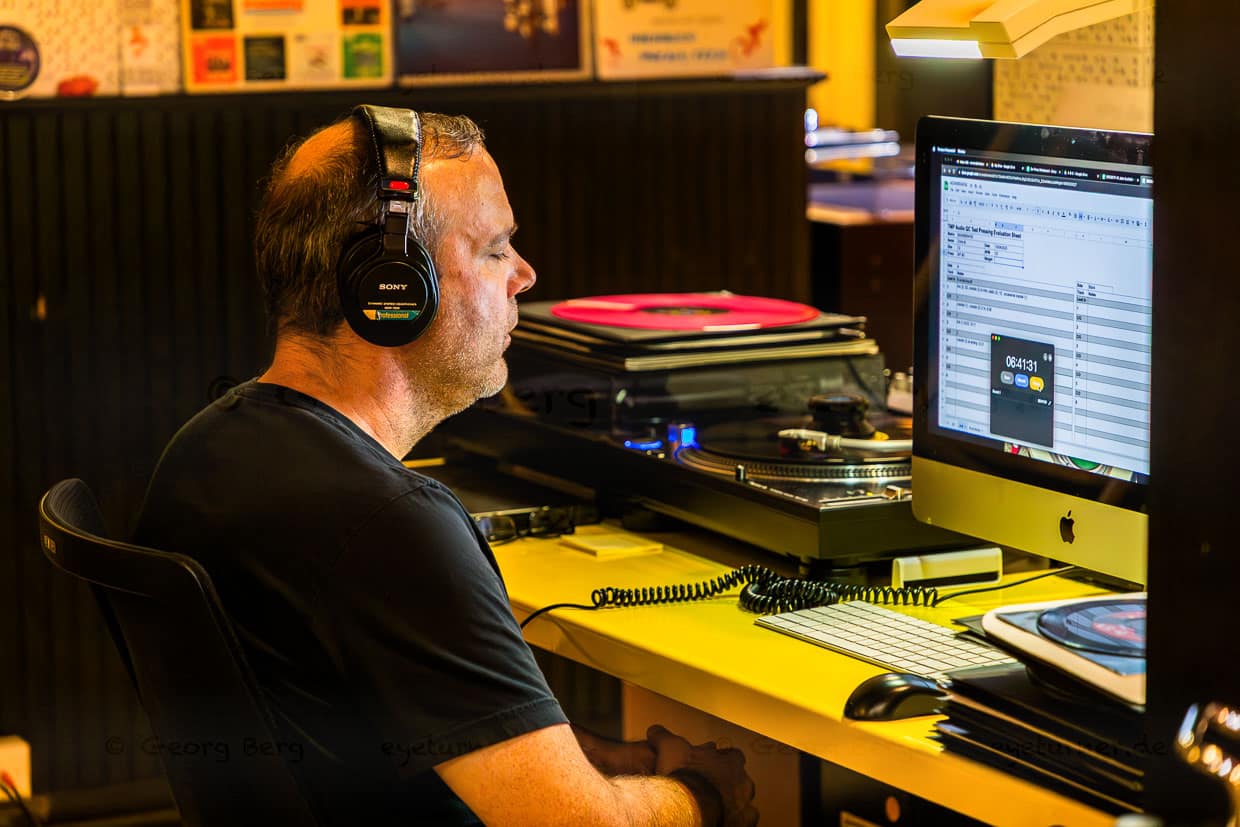“Just a moment,” says the man at the counter and disappears. We wait. It takes a while. Finally he returns: “Nothing secret is being produced today. You can go through.”

Secret? In a record factory? Yes, secret. Because at Third Man Records in Detroit, no ordinary records are made. This is where limited editions are pressed for the greats of music history. Shortly before our visit, Paul McCartney had an edition of his album McCartney III produced – exactly 333 copies worldwide. The material: melted down original pressings of his albums McCartney (1970) and McCartney II (1980). Old records were ground up, the vinyl recycled, processed into new pucks and pressed into fresh records in Detroit. Such editions are collector’s items even before they leave the factory. Billie Eilish, Metallica, Neil Young, Coldplay, Jay-Z – they have all had vinyl pressed here. Some editions are so exclusive that even the employees don’t know what they are working on.
Detroit – decay and awakening
The Detroit of two faces is already evident on the way to Canfield Street. A few blocks away from Third Man Records stands the Abundant Faith Cathedral – a simple brick building surrounded by industrial wasteland. Empty plots, derelict buildings, nature reclaiming what was once a factory. The old Detroit: Motor City, America’s fourth largest city, birthplace of mass production. This is where Henry Ford perfected the assembly line and created the middle class.

Then the crash: whites fled to the suburbs, racial conflicts escalated, industry collapsed. In 2013, Detroit filed for bankruptcy – the biggest city bankruptcy in US history. Detroit came to symbolise the decline of old jobs and professions that disappeared. Like rafting in Europe – only faster, more brutal.
Third Man Records – a factory that sounds different
But a few streets away, on Canfield Street, the other story begins. Hip brands have been moving in here since 2010. Carhartt, the workers’ clothing label, has opened a store. Shinola, the watch and designer label, opened its flagship store. And in the centre of it all: Third Man Records. Artists, musicians and craftsmen are returning. They buy abandoned buildings for ridiculously low prices and convert them. Factory buildings become studios, galleries and workshops. Detroit is reinventing itself – not as a motor city, but as a creative city, a place for people who want to work with their hands.

Jack White, upholsterer, designer, rock musician and founder of Third Man Records, is one of these returnees. In 2017, he opened his vinyl pressing plant here – a statement: Detroit’s future does not lie in nostalgia, but in craftsmanship, which has become cool again. The building on Canfield Street looks inconspicuous from the outside.

More than just a factory
Third Man Records, founded by Jack White, Ben Blackwell and Ben Swank, is more than just a pressing plant. In the front part of the building there is a sales room with a small stage for live recordings and a soundproof monitoring booth. The walls are striped yellow and black, the brand colours of Third Man Records. Vintage posters everywhere, old amplifiers as decoration – a mix of rockabilly and punk.

The machine as the star
And then: the pressing machine. A Newbilt from Germany. A new record is produced every 30 seconds. Vinyl pucks are heated, pressed between two dies, labels for the A and B sides are centred by hand – and that’s it.

The machine is the star: industrial production that you understand. No computer, no black box. You can see how the press cakes come out of the extruder, how they are pressed, how the record is made. It’s almost meditative.

Production manager Eddie Gillis gives a tour of the factory and explains every step. “We can do things here that are not possible with fully automatic machines,” he says. The semi-automatic presses need people to insert each puck individually – this is how the colourful, playful records for which Third Man Records is famous are created. The process is amazingly analogue, almost archaic: heat, pressure, time. No computers, no digitalisation. Only the quality control has become more precise, the temperature control more finely tuned. But at its core, it remains the same process as in 1948, when Columbia Records introduced the vinyl LP.



Quality by ear
Eddie Gillis also shows Third Man Mastering, where the music is mixed and prepared as a blank for the record press on a Neumann VMS-70 cutting machine. This is where the matrix is created, which is later reproduced thousands of times. The Berlin-based company Georg Neumann builds these precision machines and benefits from the growing interest in vinyl worldwide.


No algorithms, no automatic testing – human ears decide whether the record meets the standards. The atmosphere is focussed but relaxed. No hectic, no stress. Jack White emphasises on his website how important fair working conditions are to him – and you can feel it. The employees work calmly and precisely.
From McCartney to Metallica – over 800 releases
Third Man Records has long been more than just Jack White’s personal label. The catalogue includes over 800 releases. In addition to White’s own projects(The White Stripes, The Raconteurs, The Dead Weather), albums by superstars and newcomers appear here. Paul McCartney had the spectacular “333 Edition” of his album McCartney III pressed here – 333 copies made from recycled original pressings of his albums from 1970 and 1980. A mini-documentary shows the entire process: how old records were shredded, the vinyl recycled and turned into new pucks. In addition, the “3333 Edition” was released – 3,333 copies on yellow and black speckled vinyl.
A world map without countries
A world map hangs in the Third Man Record office. Instead of country names, it shows terms such as “Sand” in the Sahara, “More Sand” on the Arabian Peninsula, “Taller Rocks” in the Himalayas. The USA is called “Concrete”, Alaska becomes “Super Texas”. Detroit is labelled “You are here”. Europe? Remains empty. No labelling. As if it had disqualified itself with its changing borders.

Countries come and go. The Roman Empire, the Soviet Union, Yugoslavia – all gone. But the sands of the Sahara are older than any nation. The “Taller Rocks” of the Himalayas were there before humans existed. This map says: We make music that lasts. Vinyl that lasts for generations. We are not interested in political borders.
From “You are here”, Third Man Records sends records all over the world. After “Concrete” and “Super Texas”, after “Rainy Forest” and “Desert Island”. Even to unlabelled Europe, where the pressing machines that produce these records here in Detroit come from.
Our journey through Michigan starts in the capital Detroit with classics and new attractions of a city in transition. The huge Michigan Central station, once a ruined line, celebrated its comeback as a research location for mobility in 2023. However, the options for getting around Detroit have long been extremely diverse, as mobility in Motown works pretty well even without a car. Detroit is also seeing the return of professions that had been declared dead: At Third Man Records, limited vinyl editions are pressed for the music world – on machines from Germany, with manual labour instead of fully automatic machines. The journey continues to Traverse City on Lake Michigan with the Sleeping Bear Dunes National Park. Mission Point Lighthouse is one of these lighthouses with a history. In the story about Sarah Lane and the keeper programme, we explain why the lighthouse in Grand Traverse County is particularly popular with women. We continue on to Charlevoix. The town has a maritime flair and lots of stones. There are Petoskey stones on the beach and Earl Young’s famous stone houses in the town. USA without cars? A fact on Mackinac Island. The success story of Michigan’s heavy industry began with a defeat.
Our journey through Michigan starts in the capital Detroit with classics and new attractions of a city in transition. The huge Michigan Central station, once a ruined railway line, celebrated its comeback as a research location for mobility in 2023. However, the options for getting around Detroit have long been extremely diverse, asmobility in Motown works pretty well even without a car. Detroit is also seeing the return of professions that had been declared dead: At Third Man Records, limited vinyl editions are pressed for the music world – on machines from Germany, with manual labour instead of fully automatic machines. The journey continues to Traverse City on Lake Michigan with the Sleeping Bear Dunes National Park. Mission Point Lighthouse is one of these lighthouses with a history. In the story about Sarah Lane and the keeper programme, we explain why the lighthouse in Grand Traverse County is particularly popular with women. The journey continues to Charlevoix. The town has a maritime flair and lots of stones. There are Petoskey stones on the beach and Earl Young’s famous stone houses in the town. USA without cars? A fact on Mackinac Island. The success story of Michigan’s heavy industry began with a defeat.
The research was supported by Visit Detroit


